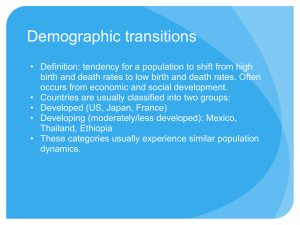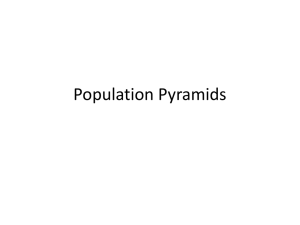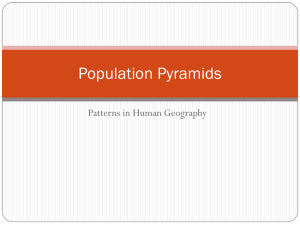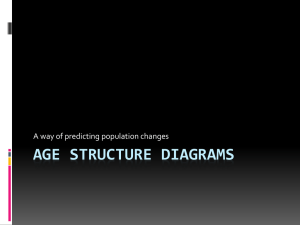Assignment - University of Calgary
advertisement
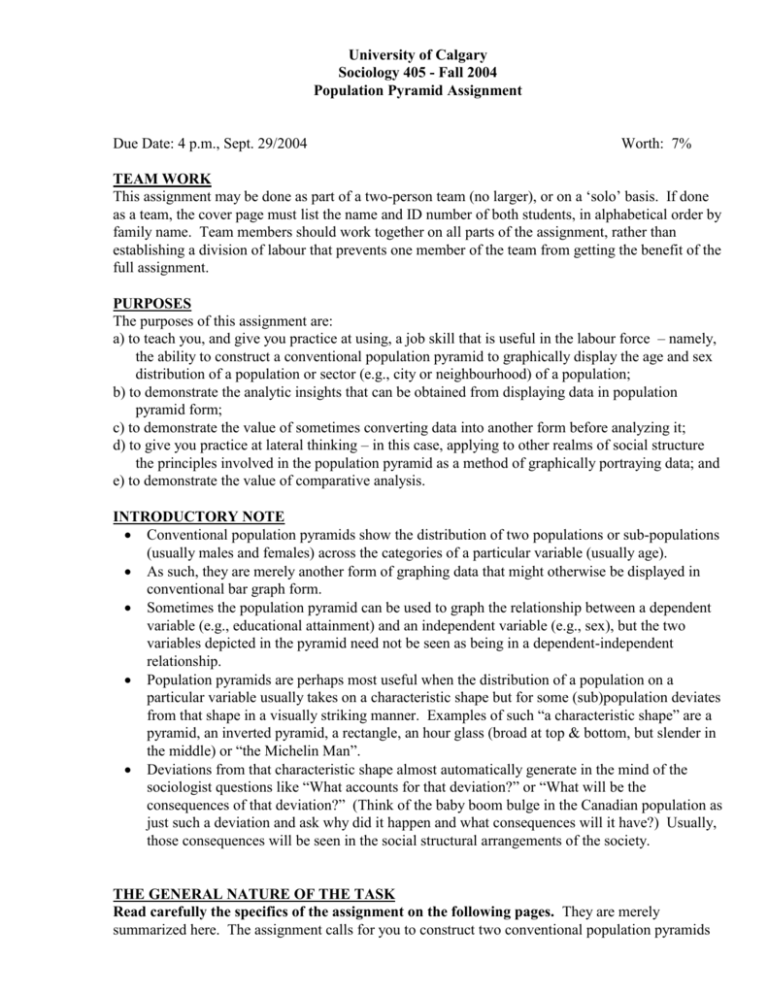
University of Calgary Sociology 405 - Fall 2004 Population Pyramid Assignment Due Date: 4 p.m., Sept. 29/2004 Worth: 7% TEAM WORK This assignment may be done as part of a two-person team (no larger), or on a ‘solo’ basis. If done as a team, the cover page must list the name and ID number of both students, in alphabetical order by family name. Team members should work together on all parts of the assignment, rather than establishing a division of labour that prevents one member of the team from getting the benefit of the full assignment. PURPOSES The purposes of this assignment are: a) to teach you, and give you practice at using, a job skill that is useful in the labour force – namely, the ability to construct a conventional population pyramid to graphically display the age and sex distribution of a population or sector (e.g., city or neighbourhood) of a population; b) to demonstrate the analytic insights that can be obtained from displaying data in population pyramid form; c) to demonstrate the value of sometimes converting data into another form before analyzing it; d) to give you practice at lateral thinking – in this case, applying to other realms of social structure the principles involved in the population pyramid as a method of graphically portraying data; and e) to demonstrate the value of comparative analysis. INTRODUCTORY NOTE Conventional population pyramids show the distribution of two populations or sub-populations (usually males and females) across the categories of a particular variable (usually age). As such, they are merely another form of graphing data that might otherwise be displayed in conventional bar graph form. Sometimes the population pyramid can be used to graph the relationship between a dependent variable (e.g., educational attainment) and an independent variable (e.g., sex), but the two variables depicted in the pyramid need not be seen as being in a dependent-independent relationship. Population pyramids are perhaps most useful when the distribution of a population on a particular variable usually takes on a characteristic shape but for some (sub)population deviates from that shape in a visually striking manner. Examples of such “a characteristic shape” are a pyramid, an inverted pyramid, a rectangle, an hour glass (broad at top & bottom, but slender in the middle) or “the Michelin Man”. Deviations from that characteristic shape almost automatically generate in the mind of the sociologist questions like “What accounts for that deviation?” or “What will be the consequences of that deviation?” (Think of the baby boom bulge in the Canadian population as just such a deviation and ask why did it happen and what consequences will it have?) Usually, those consequences will be seen in the social structural arrangements of the society. THE GENERAL NATURE OF THE TASK Read carefully the specifics of the assignment on the following pages. They are merely summarized here. The assignment calls for you to construct two conventional population pyramids using Excel software and to comment analytically on them. Then you are required to use the population pyramid format to graphically demonstrate the distribution of another variable (not age) for two populations or sub-populations (not males and females). Analytic comment on your results is then required. Specific steps in constructing a population pyramid are provided in a separate document at: http://www.ucalgary.ca/~ponting/405PopPyrConstructnInstructns Although the procedure is cumbersome, it is worth doing because it relies upon the commonly available Excel software, rather than upon some specialized software that your work site probably won’t have. SOME USEFUL RESOURCES A. CANSIM II. CANSIM II databases are accessed through the Maps, Academic Data, and Geographic Information Centre (MADGIC) on the University of Calgary Library’s website at: http://www.ucalgary.ca/library/MADGIC/index.html or, more directly, at: http://ezproxy.lib.ucalgary.ca:2048/login?url=http://datacentre.chass.utoronto.ca/cansim You’ll need information from your student ID card to access the CANSIM II site. B. Statistics Canada’s “Canadian Statistics” website at http://www.statcan.ca/english/Pgdb/popula.htm and sub-listings under it, such as: http://www.statcan.ca/english/Pgdb/popula.htm#lang C. Statistics Canada’s 2001 Community Profiles website at: http://www12.statcan.ca/english/profil01/PlaceSearchForm1.cfm D. Statistics Canada’s Aboriginal Community Profiles website at: http://www12.statcan.ca/english/profil01ab/PlaceSearchForm1.cfm THE SPECIFIC TASKS 1. Using Microsoft Excel software and the instructions found in the companion document, construct one or two (as necessary) professional-looking population pyramids to assist you in making any one of the comparisons below. Where possible, use at least ten categories (e.g., age groupings) for each sub-population. Ordinarily, you will be graphing percentage distributions, rather than raw numbers. a. the 2001 age-sex structure of Alberta & another province (See CANSIM II Table #510001) b. the 2001 age-sex structure of two large Canadian cities Statcan Catalogue #95F0486XCB2001009 probably available on CD-ROM at MADGIC on 2nd Floor of MacKimmie Library c. the age-sex structure of Canada in 1946 and 2026 For 1946 data see: CANSIM Matrix #6430 or CANSIM II Table #510026 For 2026 data, see: http://www.statcan.ca/english/Pgdb/People/Population/demo23a.htm d. 2001 distribution of the experienced labour force by sex & industry, Calgary & Vancouver, (See “Community Profiles” on Statcan website at “Some Useful Resources: C” above. After selecting the desired city, go to “Work Page 2”. e. the 2001 age-sex structure of the total (non-aboriginal) visible minority population and the total Canadian population. You may use the broad age categories found at: http://www.statcan.ca/english/Pgdb/demo50a.htm f. the 2001 age-sex structure of the immigrant (all eras) population and the total Canadian population For the immigrant population, see CANSIM II Table #510011. Use “Find” function (e.g., “0-4 years”) in Edit menu. g. the regional distribution (5 regions) of the Canadian population, 1911 and 2001 See Statcan Catalogue #11-516-XIE for historical statistics at: http://www.statcan.ca/english/freepub/11-516-XIE/sectiona/sectiona.htm#Population h. some other populations approved in advance by the instructor 2. Describe in a few sentences the most significant differences between the two pyramids. 3. Write one paragraph about the social structural ramifications of one or more of the differences you identified in part ‘2’ above. That is, what differences in social structure would be caused by the difference in the two population pyramids, and why would this be so? 4. a) Demonstrate your ability to apply the population pyramid concept and methodology to some other aspects of social structure by using the Excel software to construct a population pyramid for two other pairs of social structural variables using real (not fictitious) data that you compile yourself from an appropriate source. Neither age nor sex may be part of this. Unless you make a case for using the raw numbers, your population pyramid should show percentages. NOTE: Those percentages should total to 100% on the left side of the pyramid and 100% on the right side of the pyramid if the population on one side of the pyramid is much larger than the population on the other side of the pyramid (e.g., non-aboriginals vs aboriginals). Examples of possible variables are found below. Others not shown might be equally suitable. If in doubt, consult with the instructor. Object of Analysis (the layers or dependent variables) Comparison Populations (the two x-axis nominal categories) Income (say, 9 levels) by Visible Minority vs Not Visible Minority Official Language Spoken (English, French, Both, Neither) by Ottawa vs Montreal Educational Attainment (say 5 categories) Educational Attainment Cause of Death (say: suicide, accidents, cardio-vascular disease, cancer, other) by by Toronto vs Montreal Immigrant vs Canadian-born Aboriginal vs Non-Aboriginal by Educational Attainment by Canada vs USA Union Membership (public sector, Private sector, none) by Quebec vs Alberta Employment Status (self-employed, employee, unemployed, not in labour force) by Area of Residence (on-reserve, rural off-reserve, small city, large city) by Alberta vs Ontario Aboriginal Sask vs Aboriginal Alta. b) In a sentence or two explain why you chose the variables that you did. If you had an hypothesis in mind, state it. c) Write two or three paragraphs: - describing the distribution that you found - seeking to explain the causes of any noteworthy differences that you found between the two (sub)populations - predicting the consequences (especially social structural ramifications) of the differences you found. If you wish, you may construct two population pyramids (e.g., one for 1971 and one for 2001) and compare them as part of your discussion in ‘c’. 5. Include as an appendix your Excel worksheets that show your raw and converted data from which each of your respective population pyramids was constructed. 6. OPTIONAL: What mathematical weight do you feel this assignment should have had in the course syllabus? Answer this only after completing the assignment. -#-
